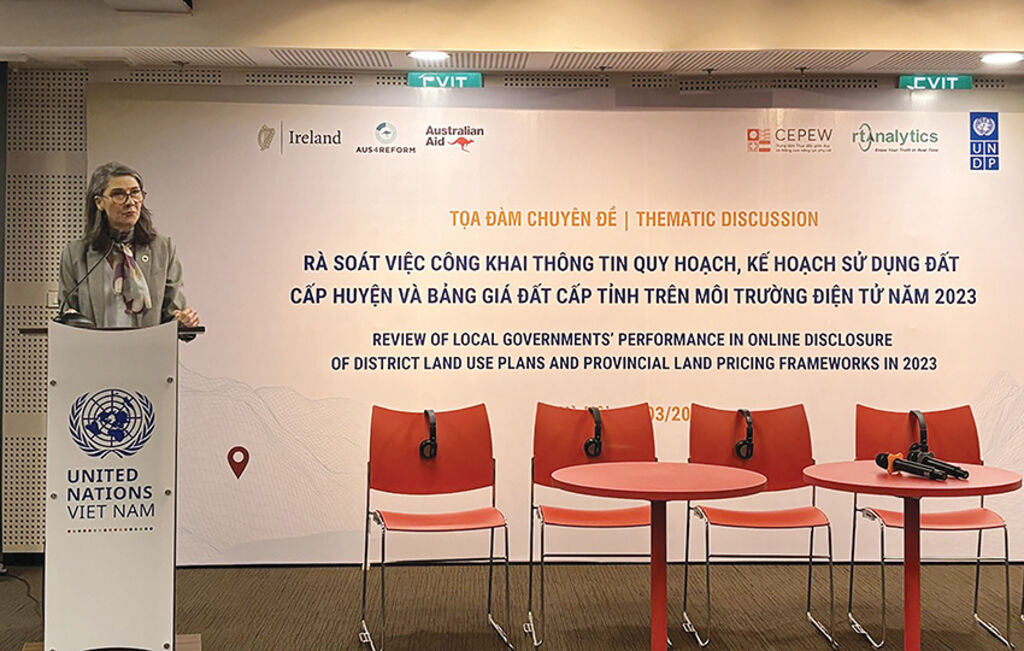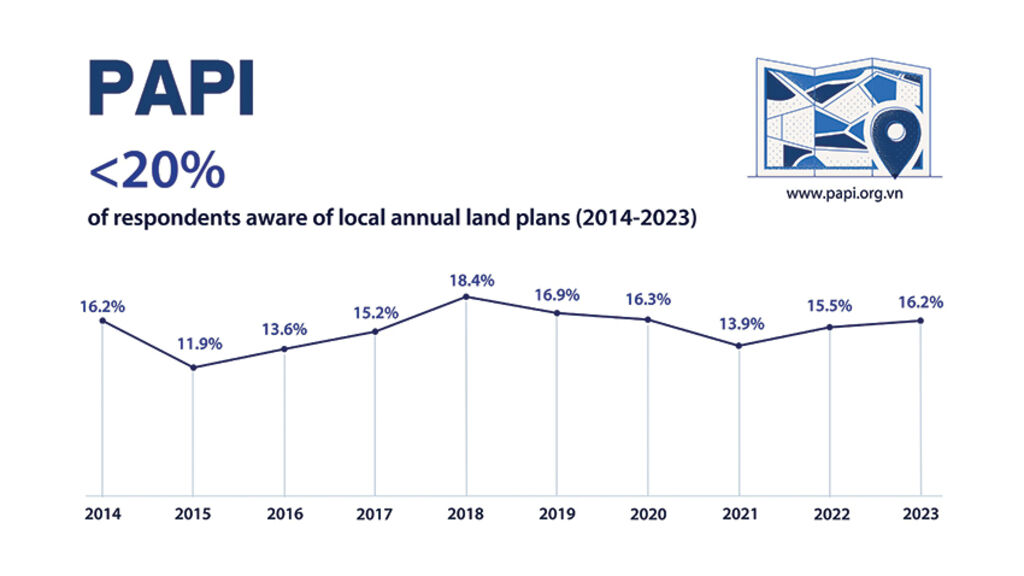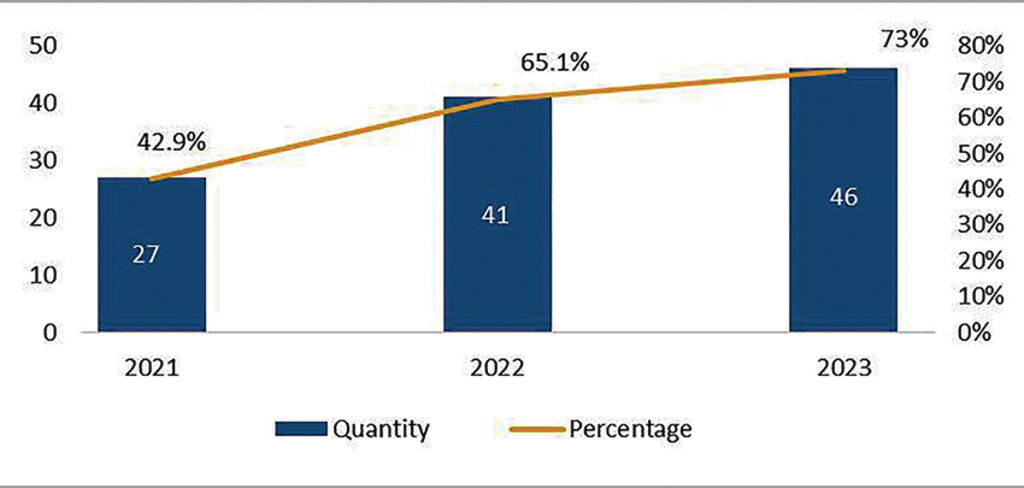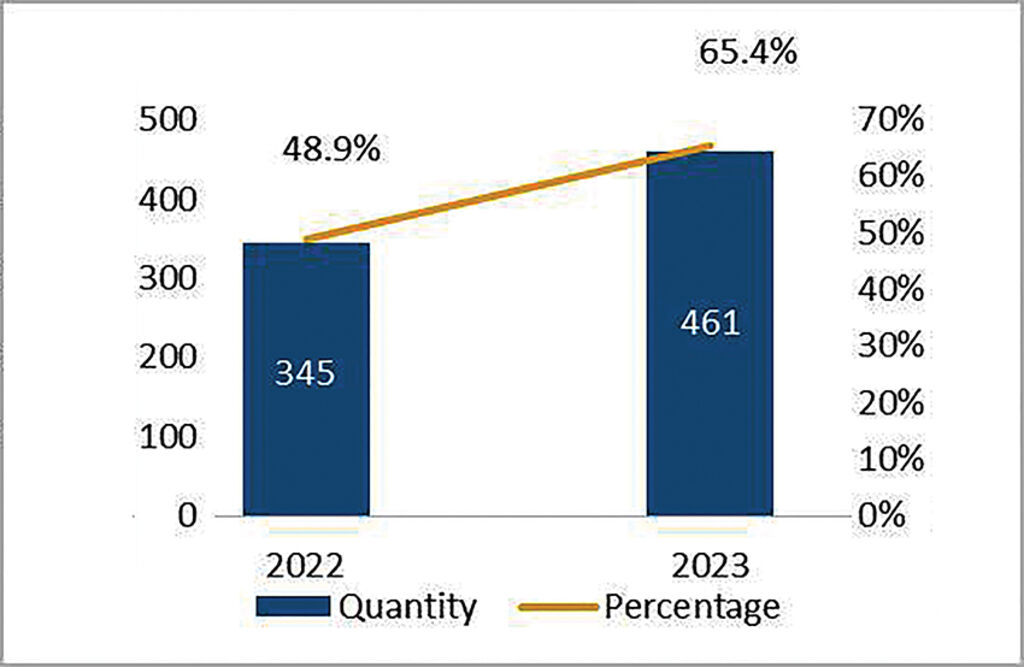United Nations Development Program, Real-Time Analytics and Center for Education Promotion and Empowerment of Women
 |
| Ramla Khalid, the resident representative of the United Nations Development Program in Vietnam, delivers a speech at the thematic discussion entitled “Review of local governments’ performance in online disclosure of district land use plans and provincial land pricing frameworks in 2023”__Photo: UNDP |
Introduction
The online disclosure by provincial and district governments of land use master plans/plans and land price frameworks significantly improved in 2023 compared to 2021 and 2022. These were the results of the 2023 review conducted by the United Nations Development Program (UNDP) in Vietnam, Real-Time Analytics (RTA) and Center for Education Promotion and Empowerment of Women (CEPEW) that were presented on March 12 in Hanoi.
The review is part of a series of annual, evidence-based studies on the disclosure of land information by local authorities in Vietnam from 2021 to the present. The review seeks to measure adherence to Vietnam’s laws on land and access to information, which specify responsibilities, processes, forms, and deadlines for disclosing information on provincial-level land price frameworks (PLLPFs), district-level land-use master plans (DLLUMPs) and annual district-level land use plans (DLLUPs), as well as an obligation to provide these types of information at the request of citizens.
This article presents key findings from the 2023 research on the disclosure of land information (10-year DLLUMPs, annual DLLUPs and PLLPFs) by local authorities in Vietnam in comparison with the 2021 and 2022 findings.[1] The annual review has been jointly conducted by UNDP in Vietnam, RTA and CEPEW since 2021. It closes with recommendations for better performance and strengthened policy measures of land transparency at the local level.
Research context and methods
Ensuring citizens’ right to access land information is often seen as an effective measure to decrease the risks of corruption and the prevalence of land conflicts, consequently increasing citizens’ trust in local governments. Citizens’ right to access to information is regulated in the 2013 Constitution and specialized in the 2016 Law on Access to Information (LAI). Recently, the provisions on citizens’ right to access to land information have been included in an article of the 2024 Land Law, strengthening the legal framework of this right.
To fully guarantee citizens’ right to land information, the 2016 LAI requires local governments to actively disclose information that is subject to disclosure, and provide information upon request in accordance with regulations. However, according to the 2023 Vietnam Provincial Governance and Public Administration Performance Index (PAPI) survey as shown in Figure 1, citizens’ access to information about local land use plans and official land pricing frames in 2023 remained limited in all provinces.[2]
 |
| Figure 1: Percentages of citizens aware of local annual land use plans, 2014-23 |
Furthermore, the first two reviews[3] of local government’s performance in the disclosure of 10-year DLLUMPs, annual DLLUPs, and PLLPFs show that the performance of local authorities in disclosing online land information had shown gradual improvements, yet at a slow pace.
In the context of ongoing promotion of digitalization of public services to the lowest level of governments in Vietnam, the third review was carried out from October 2023 to February 2024 in three phases. First, regulations on processes and authority of issuing and publicizing DLLUMPs for the 2021-30 period, the 2023 DLLUPs and PLLPFs for the 2020-24 period (below collectively referred to as land information) and on access to information, including land information, were reviewed to set up assessment criteria. Then, five criteria were applied throughout the review to examine the performance of land information disclosure by local authorities on their portals. The five criteria include: (i) information disclosure; (ii) information searchability; (iii) information timeliness; (iv) information completeness (for DLLUMPs and DLLUPs); and (v) information usability (readable, understandable, legible by using popular software and viewable online). To gather data for the review, the research team searched for PLLPFs for 2020-24 on the portals of all 63 provincial People’s Committees (PPCs) (the agencies responsible for generating land information[4] and disclosing land price frameworks[5]) as well as DLLUMPs for 2021-30 and the 2023 DLLUPs on the portals of 705 district People’s Committees (DPCs) across the country (the agencies responsible for disclosing land information[6]). After attempts on official provincial, district and sectoral portals, the last resort with Google search was also conducted. As a call for action, letters of request for land information were also sent to district governments to ask for their responses to the requests as part of the review.
2021-23 review findings: significant improvements amid drawbacks in online disclosure of land price frameworks, 2021-30 district land-use master plans and annual district land use plans
This section presents key findings regarding the status of land information disclosure on provincial and district governments’ portals from the 2023 review. The findings suggest that, whilst many local governments have made improvements in disclosing land information online, more should be done to fully ensure citizens’ right to land information as required in the 2024 Land Law.
More land price frameworks disclosed on local governments’ portals in 2023 than in 2021 and 2022
Regarding the transparency of land price frameworks for the 2020-24 period, as shown in Figure 2, nearly three-quarters of 63 PPCs disclosed information on their portals in 2023, a significant increase from 43 percent in 2021 and 65 percent in 2022. Among 46 PLLPFs found disclosed online in 2023, 44 included the decisions of PPCs issuing the respective land price frameworks (95.7 percent), and the other two included the resolutions approving the land price frameworks of the provincial People’s Councils (4.3 percent).
 |
| Figure 2: Comparison of the disclosure of PLLPFs between three reviews |
It is important to note that PLLPFs for 2020-24 have been in place for nearly four years and will be effective until December 31, 2024. Meanwhile, as many as 27 percent of PLLPFs could not be found on PPCs’ portals as of October 6, 2023. This means that the disclosure of land price frameworks on provincial governments’ portals has not met the timeliness requirement in accordance with the land legislation. Specifically, the 2013 Land Law requires the disclosure of provincial-level land price frameworks to be made on January 1 of the first year of the period, which is January 1, 2020.
 |
| Figure 3: Disclosure of DLLUMPs for 2021-30 on websites/portals of DPCs in 2022 and 2023 |
More district-level land-use master plans for 2021-30 disclosed by district People’s Committees in 2023 than in 2022
The review of the disclosure of the 2021-30 DLLUMPs has been conducted since the second review in 2022. Figure 3 shows that the disclosure of DLLUMPs online improved. In 2022, out of 705 DPCs nationwide, only 345 posted their DLLUMPs on their portals (accounting for 48.9 percent). However, in 2023, DLLUMPs were found on 461 DPCs’ portals (65.4 percent), an increase by 16.5 percent.
In terms of searchability, 62.7 percent of the disclosed DLLUMPs were found in the land-related information section entitled “land use master plan/plan”, 23.2 percent were found in unrelated sections, 9.8 percent were found by using the search bar on the homepage of the portals and 4.3 percent were found by using Google search. Compared to the second review in 2022, these results corresponded to an increase of 96 document sets found in land-related sections.
Regarding the timeliness and completeness of disclosed information, among the 461 DLLUMPs that were posted online, 147 were disclosed within 15 days from the date of issuance as regulated in the 2013 Land Law, while 166 were disclosed after 15 days from the date of issuance and 148 with unknown date of issuance or disclosure. As for the completeness of the sets of posted DLLUMPs, 250 DPCs fully disclosed three must-be-disclosed documents, including approval decisions, explanatory reports, and land-use master plan maps (54.2 percent). Compared to the second review, there was an increase of 79 DPCs fully disclosing land-use master plans with all three required documents.
With respect to searchability, of 461 DLLUMPs, 62.7 percent were found on DPCs’ portals as opposed to 4.3 percent from Google search. Compared to the 2022 findings, there was an increase of 96 DLLUMPs sets found on DPCs’ portals, and a decrease of nine DLLUMPs found from Google search, respectively. This suggests that searching for land-use master plans has become more convenient as many DLLUMPs were posted explicitly in land-related sections on DPCs’ portals.
 |
| Figure 4: Disclosure of DLLUPs on DPCs’ portals |
More than half of DPCs disclosing the 2023 district land use plans online, a steady increase from 2021 and 2022 numbers
Similar to the disclosure of PLLPFs and DLLUMPs, the proportion of annual DLLUPs found on DPCs’ portals also increased in 2023 compared to 2021 and 2022. As Figure 4 shows, DLLUPs were found on 337 DPCs’ portals (47.9 percent) in 2021, and on 389 DPCs’ portals (55.2 percent) in 2022. In the third review, the 2023 DLLUPs were found on 460 DPCs’ portals, accounting for 65.2 percent of all 705 DPCs nationwide, or an increase of 17.3 percent compared to the 2021 review and 10 percent compared to the 2022 review.
Figure 5 reveals the proportion of DPCs from each of all 63 provinces that disclosed the 2023 DLLUPs on their portals. Accordingly, seven provinces, namely Dong Thap, Tra Vinh, Tay Ninh, Binh Phuoc, Binh Thuan, Ninh Thuan and Phu Yen, had all DPCs disclosing their DLLUPs on their portals. At the other end of the spectrum, Hoa Binh and Dien Bien are the two provinces with the lowest number of DPCs disclosing their DLLUPs online, at only 20 percent.
 |
| Figure 5: Proportion of DPCs in provinces that disclosed DLLUPs on their portals in 2023 |
Regarding the timeliness of information, of the 460 DLLUPs that were found, 105 were approved on time before December 31, 2022, but only 32 of them were disclosed on time (7 percent), while 48 were disclosed after 15 days from the date of issuance (10.4 percent), and 25 were disclosed at an unknown date (5.4 percent). As many as 343 DLLUPs were approved on or after December 31, 2022, of which only 169 were disclosed within 15 days from the date of issuance.
On the completeness of information, among the 460 DPCs that disclosed information, 233 DPCs fully disclosed all three required documents (including approval decisions, explanatory reports, and land use plan maps), while only 23 DPCs disclosed approval decisions and explanatory reports, 70 DPCs disclosed approval decisions and maps, 14 DPCs disclosed explanatory reports and maps, and 120 DPCs disclosed one of the three mandatory documents. Compared to the 2022 review, there was an increase of 172 DPCs disclosing the DLLUPs in full.
Drawbacks in disclosing land information on portals of state agencies at provincial and district levels
There were several reasons for the drawbacks in disclosing land information on local governments’ portals. First, technical limitations may be an explanation for the slow increase in the online disclosure of land information from 2021 to 2023. For instance, some PLLPFs were recorded as having been disclosed in 2022 but were no longer found on PPCs’ portals in 2023. The 2022 posts no longer existed and/or the links to the documents no longer worked, such as in Cao Bang and Phu Tho provinces.
Second, the practice of posting multiple documents in compressed files that need to be downloaded to be viewed on personal devices was still common, causing inconvenience for phone users to access land information. Similarly, explanatory reports have been posted in <.doc> format without official stamps and signatures of authorized persons. Likewise, land use plan maps have been posted in formats that are unfamiliar to ordinary users (e.g., <.dng>); or disclosed documents have been divided into sets that have made it difficult for users to follow in flow.
Third, the disclosed documents were inaccessible for visually impaired persons. The search tools of many local governments’ portals were inactive, making them impossible for visually impaired users to find land information. For those search tools that enable the search, most uploaded documents were in picture formats, which are not readable even with assistive software. Besides the visually impaired, other groups, such as the elderly and ethnic minorities not fluent in Vietnamese, also face obstacles in accessing land information on the portals.
District authorities’ responses to citizens’ requests for information about DLLUPs: higher but still low and slow
One important experiment as part of the review was about sending requests for land information to relevant district-level government agencies to examine how the 2016 LAI has been implemented by local governments. The requests were sent to the offices of 561 out of 705 DPCs by four persons, including an ordinary citizen, a lawyer, a real estate agent and a researcher. All the letters of request for information about annual DLLUPs were addressed to Offices of district People’s Committees or People’s Councils in accordance with Article 9.2.g of the Law on Access to Information.
By December 31 of last year, 23.7 percent of DPCs provided the requested information, 1.1 percent rejected, 5.3 percent responded but did not provide information, 67.9 percent did not respond, and 2 percent returned the letters as the security guards refused to accept the mail due to the absence of a specific recipient’s name. The positive trend is that the proportion of state agencies providing the information as requested increased by 6.2 percent compared to the first review in 2021. At the same time, the rate of DPCs refusing to provide the information decreased from 2.7 percent in the first review to 1.1 percent in the second and third reviews.
The non-response rate remained high at 67.9 percent in 2023, although lower than that in 2021 (71.7 percent) and in 2022 (74 percent). With more than half of the DPCs receiving the requests but refusing to respond, this suggests the limitations in the performance of administrative procedures in accessing information via post, making it difficult to guarantee a response.
When broken down by the four types of request senders, the 2023 results showed that of the four senders (each sending requests for land information to 140-141 DPCs), the researcher was the one that received the most responses (30 percent of the total requests sent). Meanwhile, the proportions of DPCs that responded to the citizen, the lawyer and the real estate agent were almost the same at 22.1 percent, 21.4 percent and 21.3 percent, respectively.
Regarding the timeliness of DPCs’ responses to the requests for information about DLLUPs, out of total 142 responses received by the research team, 111 were received within 15 working days from the date of sending and five after 15 working days. Also, among the total responses, 22 DPCs responded without information about DLLUPs within 15 working days, and four after 15 working days.
Conclusions and recommendations
In conclusion, ensuring the citizens’ right to access information on land management, planning and use is one of the key objectives set out in Government Resolution No. 37/NQ-CP of 2023.[7] To achieve this objective, it is important to ensure that the disclosure of land-use master plans, annual land use plans, and land price frameworks is in line with existing laws and regulations. With the e-government optimistically promoted in Vietnam, the portals of state agencies are becoming a more common and important channel for people to find official information released by government agencies.
As the research findings of three rounds reveal, the rates of disclosure of PLLPFs for the 2020-24 period, DLLUMPs for 2021-30, and the 2023 DLLUPs in the third review increased compared to 2021 and 2022 findings. Also, the experiment with sending requests for DLLUPs suggests positive responses, with an increase in the response rates. The Box below highlights good practices found in 2023 for other provincial and district governments to learn from.
Despite the improvements in disclosing land information online by a larger number of local governments, there is still room for those local government agencies that have not either disclosed the land price frameworks, the 2021-30 land use master plans and the annual land use plans to fulfil their mandates as provided in the 2024 Land Law and the 2016 LAI. More importantly, local governments should proactively respond to citizens’ requests for land information as required by the laws. Below are key suggestive courses of actions to improve both policy and practice in land transparency:
(i) Including the procedure for information provision at the request of citizens in the current set of land-related administrative procedures during the process of formulating documents guiding the 2024 Land Law;
(ii) Developing a mechanism to assess the disclosure of information and sanctions in case relevant authorities fail to fulfill their responsibilities properly and fully for the disclosure of information, including land information;
(iii) Providing regulations obligating government agencies to provide upon request the information for which they are responsible for disclosing;
(iv) Developing an “Access to Information” section on local governments’ portals and organize information in this section in accordance with Article 19 of the 2016 LAI to facilitate citizens’ ease of access. It is important to ensure that the search bar on portals works effectively so that users can easily search for information and do not miss the information disclosed in the distant past;
(v) Formulating and publicizing regulations on access to information; assigning and publicizing contact details of focal points for information provision; and ensuring that the disclosed information remains constantly accessible, at least for the duration as provided in the 2016 LAI. It is a must for local governments to use the domain names of local governments’ portals in accordance with Government Decree 42/2022/ND-CP, and that provincial-level People’s Committees’ portals have links to portals of district-level and commune-level People’s Committees;
(vi) Providing regulations requiring the interfaces, structure of information sections, and modes of information disclosure to be developed in a standardized and consistent manner across all state agencies’ portals. Specifically, standardized portals for People’s Committees at all levels should be designed and applied to accommodate information sections. Local governments’ portals must ensure efficiency in searching and accessing information, adopting user-friendly, user-centered approaches;
(vii) Applying mandatory regulations for upgrading these portals to Web Content Accessibility Guidelines 2.2 (WCAG 2.2) standards instead of the current WCAG 1.0 ones. Accessibility for vulnerable groups, including persons with disabilities, must be adhered to from the designing to the upgrading phases of local governments’ portals; and,
(viii) Continuing to disseminate and provide training on the 2016 LAI, Government Decree 13/2018/ND-CP and Decree 42/2022/ND-CP for public officials and civil servants as well as to citizens, especially regulations on the procedures for disclosing information and providing information at citizens’ request.-
[1] See review result maps and full reports on the annual reviews at https://www.congkhaithongtindatdai.info/.
[2] For more information about PAPI, see www.papi.org.vn/eng.
[3] For the first review (2020-21), see Vietnam Law and Legal Forum (April 8, 2022), Improvement in local governments’ performance in disclosure of land information a must: action research results suggest. Available at https://vietnamlawmagazine.vn/improvement-in-local-governments-performance-in-disclosure-of-land-information-a-must-action-research-results-suggest-48853.html. For the second review (2021-22), see Vietnam Law and Legal Forum (September 28, 2023), Slow progress in online disclosure of land information by local governments and strengthened land transparency regulations much needed: action research results show. Available at: https://vietnamlawmagazine.vn/slow-progress-in-online-disclosure-of-land-information-by-local-governments-and-strengthened-land-transparency-regulations-much-needed-action-research-results-show-70557.html.
[4] Article 2.2 of the 2016 Law on Access to Information provides: “Information generated by a state agency refers to news and data which are generated during the execution of functions, tasks and powers by such state agency as regulated by the law. The instrument containing such information must be signed, sealed or certified by the competent official of such state agency.”
[5] Article 114.1 of the 2013 Land Law.
[6] Article 48.2.a of 2013 Land Law.
[7] See Government Resolution 37/NQ-CP March 17, 2023, on the issuance of the Government’s Action Plan on implementation of Resolution 18-NQ/TW on June 16, 2022, of the 5th Central Party Committee, on “Continuing to innovate and improve institutions and policies, improving the effectiveness and efficiency of land management and use, creating motivation to bring our country [Vietnam] to a high-income developed country”.









